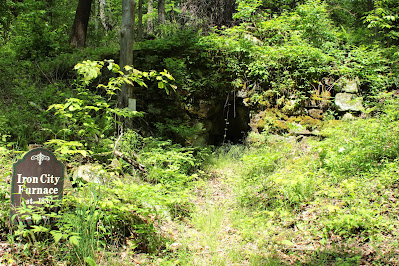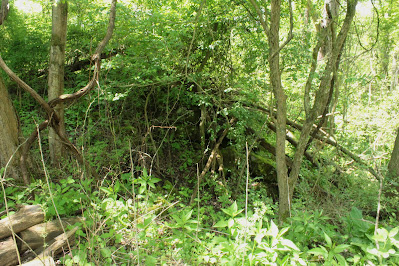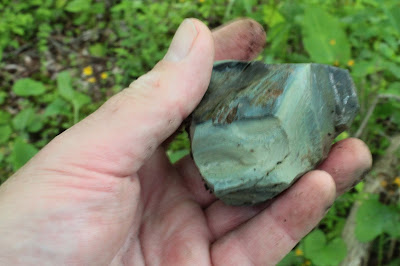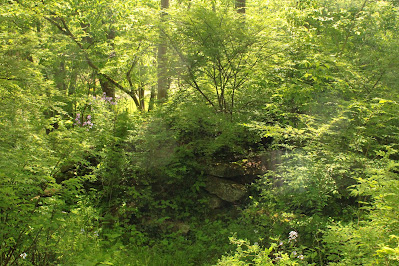Cautiously I entered what appeared to be a large bowl, the dirt was layered with different colors and hues. The surface looked hard but it crumbled as I ran my finger across it. I could easily stamp steps into it should I need to.
An abandoned cement block building sat near the entrance with a large high tension tower sitting behind. Trash and barrels sat around the building with a half open garage door at its far side. I’d come back to that later.
The bowl was large, maybe 40 or 50 feet across. It looked as if it had been formed by the wind or by water. A small opening was on one side of it, the edges rounded by time. Glancing inside I saw a small hole in the roof near the back, the light filtering in illuminating the small space, highlighting the variations in the coloring of the surface.
I was searching for…something, I wasn’t sure what. I knew it was near-by and I knew I would know it when I saw it. Whatever it was I knew it was important! Suddenly a alarm started ringing and I abruptly left my dreams and returned to reality. It wasn’t an alarm; it was my bladder that was calling. Much as I wanted to go back and find whatever I was looking for, I knew it would be useless, my dream and my sleep had been left behind!
I knew that the idea of sleep was impossible, the alarm beside my bed was set for about an hour later. I knew I would just toss and turn. There was another trip on my calendar and the excitement of it wouldn’t let sleep slip in! I gave up and made some coffee.
A few hours later, I met Frank Festa and his buddy Jeff at a local gas station. After a cup of coffee and some light BS we loaded my gear into his car and we headed north on rt.8.
We were going on an iron furnace tour. Frank and Jeff are also “experienced furnace hunters”. We had already been to the furnaces on our list but it was the idea and the excitement of seeing them again and comparing them to how they looked when we were there last, ½ a year or even 10 years ago, that brought on this trip.
Our first stop was to the east of Harrisville, on Creek Bottom Rd. We parked the car and dropped over the hillside, looking for the Marion Iron Furnace, or what was left of it.
Entering the woods I was reminded of a tropical rain forest. The ground and branches we passed under were all wet. It was warm and everything was green. Other than the birds chirping, all was silent except for our footsteps. The logs were covered with moss and skunk cabbage was sprouting near the creek. Ferns were everywhere. Our pant legs were drenched almost immediately. Mosses on the rocks made them blend in with everything else, making walking difficult. Moving up the stream I didn’t see the furnace and I started doubting my memory and then I saw it, a large mound of rocks, green like everything else.
The furnace sits right in front of a water channel built at the same time as the furnace. The Marion furnace is listed as being built around 1848-1850. It produced iron only until 1862. A short distance upstream from the furnace sits the remains of a dam which fed the channel in front of it. I imagine there was a water wheel here at one time.
Only one opening remains. The rest of it is just a pile of green stones. Above it was the plane of an old road and downstream from it we found both a couple pieces of iron and LOTS of slag. The slag is a byproduct of the iron making process; it needs removed from the top of the molten iron before the iron can be poured into the molds, called pigs.
We left the furnace and headed NW towards Mercer crossing beautiful farms interspersed with batches of woods. We passed a weird stone structure on our way so naturally; we stopped to look and photograph. We have no idea what it is or was.
Further on up the road we came to the first of two similarly named furnaces. Which one is really the Iron City Furnace is unknown but for us, I will call the first, Iron City Furnace North and the second, Iron City Furnace South. The two furnaces lie about two miles apart.
The first, (ICFN) sits near a golf course. It is rather small and looks as if it was built into a hillside. Was it an iron furnace? There is only one opening visible and has a rather large opening on top. There are no loose stones lying around and no visible slag in the near-by stream. The stones which make up the outside of furnaces are often taken to build other structures after the furnaces are shut down. The topography of the land often changes also, some of the furnace could still be underground, and the small opening could be the top of a much larger opening. (?)
There is signage which says the furnace was built in 1838 and a bit downstream is a poorly made, plywood waterwheel hung across the stream. The near-by wooden bridges and rope handrails are showing their age and I chose to walk across the stream rather than chance using the bridges.
The second furnace, (ICFS) isn’t much more than a large pile of stones. Wild rose bushes and other brush cover it, making it hard to get a complete view of it. Several courses of stone can be seen still standing in places and I know from a previous visit that one of the openings is still there, though protected now by fallen sticks and many heavily thorned branches. By forcing your way though the heavy brush, you can see the chimney opening
The side furthest from the road, probably where the casting opening was has many stones visible, tumbled against one another. On this side there are many pieces of slag lying around on the ground, something we didn’t notice at the previous furnace
This caused us to think that the first one (ICFN) was a smaller furnace, possibly used to reheat the iron to further form it into shapes to be used elsewhere. The second furnace (ICFS) seems so much larger and has the debris related to iron furnaces scattered around it. We may never know.
The bible for old iron furnaces hunters written by Myron Sharp and William Thomas, A Guide to the Old Stone Blast Furnaces in Western Pennsylvania, says that the Iron City Furnace was built in 1846 or possibly 1838 and went out of blast by 1865. The directions in it SEEM to be for the second (ICFS) site.
Our journey then took us further south, not far from Volant below a beautiful waterfall. The Springfield Furnace was built here around 1837 and produced iron until 1862. A sign posted beside it calls it the Seth and Hill Furnace, noting that it was the first furnace built in Mercer County. The furnace remained in use until 1867. It had a huge 18 foot waterwheel that was powered by the water flowing over the falls. Remnants of the waterway can be seen leading towards the furnace when viewed from above.
The furnace was partially covered in dirt and was later dug out by owners of the property. A jewelry store used to be located above the furnace, some of the items they sold was jewelry made out of the slag found around the area. A brewery sits here now and some of the paths leading to their outdoor seating are covered with crushed slag. Slag is everywhere you look here! The ruins are included in the brewery’s location, a fire ring sits in the mouth of the furnace and Corn-hole boards sit near-by the tables scattered on the patio around it. The area is more an entertainment venue than a historical site.
The sound of the water pouring over the falls was with us as soon as we opened the car doors. Being a big fan of old iron furnaces, I would have to say that the falls were my favorite thing about this site. Chances are we (AMB and I) will visit here again; the idea of sipping on a mug of beer and sitting by the falls for an hour or two sounds pretty good!
The next stop was on the edge of McConnell’s Mill State Park, alongside Slippery Rock Creek. This is where perhaps one of the best preserved iron furnaces in Western Pennsylvania sits. The Wilroy furnace was built in 1854. It is very difficult to get to and perhaps this is one of the reasons it is so well preserved. People upstream have the land posted and on the other side is a highway. The stream is wide and rarely shallow enough to cross by foot. This results in a furnace with no trash around it and no graffiti. Someone has kept up with occasional clearing of near-by trees and shrubs and there aren’t any major trees digging their roots in between the stones.
Taken in April of 2022
The furnace has 5 tiers of stone with three openings. A small bit of stone has fallen from the top but the majority of it remains. I can only hope it will become available to furnace lovers in the future!
Ann Marie and I have visited it a few times but on this trip we weren’t able to get near it. We had to view it through the trees from the far side of the stream. What little we could see of it still looked magnificent!
About fifteen miles further south brought us to the far end of the Zelienople Airport. A nice big sign greeted us as we pulled into in a small parking area. A wide path led us into the woods to a pile of rocks which was all that remains of the Bassenheim Iron Furnace. Though the airport is in Butler County, the furnace sits across the county line in Beaver.
This furnace, built in 1813 was one of the first iron furnaces in Western Pennsylvania. It produced about 5 tons of iron a week during the ten years (+/-) it was in blast. We slipped down the steep hillside beside it to the creek below hoping to be able to see more of it but thick brush covered anything that might be there. We found a couple pieces of slag in the stream but not much more. Above, only the top of the furnace is visible, just a couple courses of rock and that is rapidly becoming overgrown with foliage. Should you want to force your way to the top, the chimney opening can be seen. This was the least exciting furnace we visited.
From there we headed back to where my car was parked. The trip was a success, we visited one more furnace than what we had planned, the weather was just right for a trip, and the good companionship made it even better! We were on the road for about eight hours; eight hours well spent!
There is something I find fascinating about finding these remnants of what used to be a thriving community and business. Everything is gone, the buildings, the houses and the machinery. Unlike the past these sites are quiet. Occasionally there are walls still standing, that used to hold equipment, control the earth’s movement or to diverge water but most often, it is only the stones which made up the furnace that remain, piles of stone, continuously being hidden by nature.

































.jpg)



.jpg)

.jpg)
.jpg)









